Analysis - As Americans prepare for November 2008, the "cyber election" mandating much of the focus on campaigns has come into full swing. TG Daily had a look at the divide in how Republicans and Democrats are handling the new technology.
The history books may document the 2006 midterm election as the first major election to have the Internet as a significant influence, as it was the first one to see YouTube and official candidate MySpace pages. However, because of the increase in popularity in these and other online services, and by the enormous impact of a presidential election, the 2008 race is poised to use the World Wide Web like never before.
One of the main things seen for the first time in the dawning of the 2008 election is the addition of a special "face the candidates" page on YouTube. Sixteen candidates, eight each on the Republican and Democratic side, each have their own official YouTube pages with anywhere from a couple dozen to hundreds of campaign videos. Users can also filter official videos by issues such as education, immigration, and health care.
YouTube has made this presidential debate the first one where voters can literally see the candidates at every one of their campaign stops, see their best debate moments, and watch over specially made video blogs or commercials. And with YouTube available on various mobile phone services, the official videos are viewable on demand anytime, anywhere.

The data used for this article was limited to the top six candidates, because candidates beyond that on both the Republican and Democratic side havean estimated support of only 1% or less of the voters. The popularity information was based on the latest USA Today/Gallup poll dated December 2. The YouTube view numbers were recorded during the evening of December 6. The top five videos were determined by ranking the number of views of video clips that have been officially posted by each respective campaign.
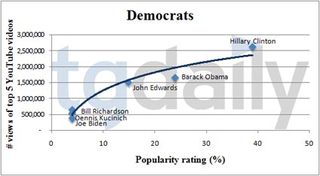
One of the most intriguing facts we found was that the number of views of the Democratic candidates' top five videos is almost perfectly correlated to their respective poll rating from USA Today/Gallup. In fact, the correlation value is an astounding 0.982. That is about as linear as it can get.
Bill Richardson, Dennis Kucinich, and Joe Biden, each with 4% of the vote, are clustered together in relation to where the top three candidates are. John Edwards, Barack Obama, and Hillary Clinton have all pulled out of the pack. Clinton is way out in front with more than 2.6 million views, followed by Obama and Edwards, right in line with where they fall on the primary poll.
Stay on the Cutting Edge
Join the experts who read Tom's Hardware for the inside track on enthusiast PC tech news — and have for over 25 years. We'll send breaking news and in-depth reviews of CPUs, GPUs, AI, maker hardware and more straight to your inbox.

Obama has the greatest lead over his competitors with regard to the number of users who have subscribed to his YouTube page. He takes the top spot with just over 13,000 subscribers. That's almost twice of his closest competitor, Clinton, who has around 7000 subscribers.
Kucinich's devotees pull him ahead of Biden and Richardson with nearly 5000 subscribers, which even puts him ahead of Edwards, though just barely.
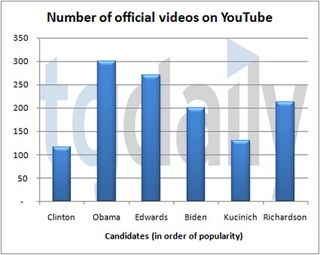
Obama also takes top rank in the Democratic party for having the most official YouTube videos, at just over 300. Edwards is close with 270 videos, followed sequentially by Richardson, Biden, and Kucinich. Surprisingly, Clinton has the fewest official videos at 116.
Clinton's campaign is clearly going for quality over quantity, given the fact that the top five videos on her page have a combined 2.6 million views, which puts her ahead of all Republican candidates as well.

The biggest disparity within the Democrats is in the number of comments received for each candidate's official videos. John Edwards, who kind of just blends in the background most of the time, actually had the most actively commented official videos on YouTube. His top five videos in terms of number of comments reach a total of nearly 9000.
Obama is next at just over 8000, and then no other candidate comes close. Kucinich is third, benefiting from being the oddball of the group.
Overall, though, the top three candidates seem to be the ones who stand out the most on YouTube's official channels. However, there's actually a completely different phenomenon happening on the Republican side.
{mospagebreak}
In a counter-intuitive turn, the trend for Republicans is actually that the number of YouTube videos watched goes down as the candidate's popularity level increases. This is largely due to a huge difference between frontrunner Rudy Giuliani and "backrunner" Ron Paul.

Check out the number of views Giuliani's top five videos have received - just over 585,000. His strongest contender, Mike Huckabee, has more than double that, at over 1.5 million views. Even Mitt Romney, who has less than half of the early votes that Giuliani has, beats him with over 890,000 views. Then, of course, Ron Paul beats everyone else with over two million views, despite only raking in 4% of the poll takers.
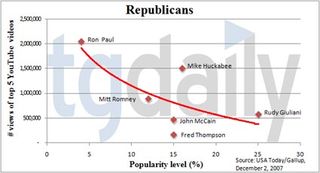
The correlation between popularity level and number of YouTube video views is -0.628, which indicates a fairly strong connection between the two variables, but in a negative way. This is most definitely because of the disconnect between Republicans and Democrats.
Republicans are typically viewed as older people, usually white collar workers who perhaps don't have a lot of free time to go on the Internet just to watch random videos from their favored presidential candidate. A part of the mismatched results between Republicans and Democrats suggests that the YouTube target is more closely aligned with the Democratic target. Additionally, Democrats prefer Ron Paul over all other Republican candidates.
Also, Ron Paul appears to be acting as a wild card with his views that sometimes systematically alienate traditional and mainstream Republicans. It is our impression that his viewership numbers are linked to users seeking entertainment value than strict candidate loyalty.
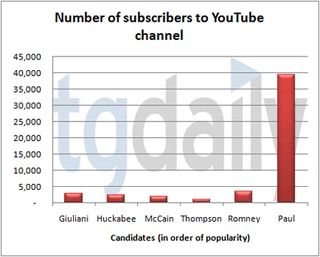
The Ron Paul factor leaves other Republicans on unsure footing. While the rest of the pack are struggling to get 5000 users to subscribe to their official YouTube pages, Paul has already secured nearly 40,000.
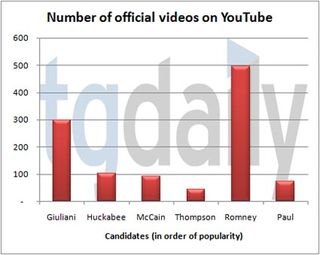
Surprisingly, though, Paul only has 73 official videos on his YouTube page, one of the lowest numbers in the entire presidential campaign. Mitt Romney actually pulls the lead here, with 497 official videos. It's also one of the higher-rating metrics for Giuliani, with 298 videos on his official page.
One interesting note for both of these charts is that Fred Thompson, once referred to as the most actively online Republican candidate, is at rock bottom. He only has 44 videos under his account name, and only 923 people have subscribed to his YouTube page.
Though he participates often in blogs and Internet message boards, Thompson seems to be leaving YouTube aside. In turn, the video sharing site hasn't been kind to him since he officially announced his bid for the presidency. Right after his first debate, Thompson was maligned for his stumbling and bumbling performance, creating a bevy of montages highlighting his not-so-greatest moments.
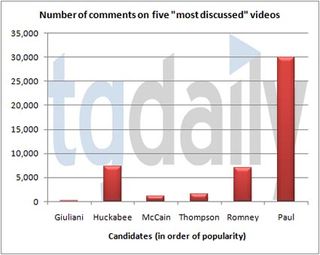
Once again, Ron Paul goes out way in front in terms of the number of comments seen on his most active official videos. Around 30,000 comments have been logged in his five most-commented videos, an impressive number that is actually more than what all six of the top Democratic candidates combined can claim.
Thus, even though Huckabee and Romney appear small on the chart compared to Paul, their comment totals are near those of the Democratic frontrunners. So even though, on the whole, official Republican videos aren't getting as many viewers, some of the candidates are getting more comments.
An interesting trend across both Republicans and Democrats is that the frontrunner had a significantly smaller amount of comments on their official videos than the next highest-ranked two candidates. Giuliani's statistic almost looks like a typo. His five most actively commented-on videos have a total of just 179 comments. Giuliani is also known for being one of the least active candidates in the online scene, and even so he remains popular among the Republican base.
The disconnect can also be drawn to early reactions to the CNN/YouTube presidential debates held earlier this year. While Democrats were eager to attend the flagship debate with questions from "ordinary citizens", Republicans were a little more hesitant.
Following the Democratic debate, Mitt Romney gave an oft-repeated remark: "I think the presidency ought to be held at a higher level than having to answer questions from a snowman," he said. One of the video questions in the debate came from a man dressed in a snowman costume.
The Republican CNN/YouTube debate had to be pushed back a few months because of Romney, as well as Giuliani, both of whom said they had scheduling conflicts with the original September date, but not until after the Democratic debate aired.
So what does all of this mean for the election?
{mospagebreak}
Politically-savvy tech heads will probably remember last year's biggest flub caught on YouTube, Virginia Senator George Allen's questionably racial slur, calling an African American "macaca". Allen was seen as a can't-lose incumbent but ended up giving his Senate seat to the Democratic candidate, thanks to the unfortunate comment that was heard across the country. And who could forget Howard Dean's "I have a scream" speech back in 2004, when e-mail was still a dominant means of spreading viral media?
What will be the big campaign-killing video this year? The answer may be rooted in the examples noted above. The candidates are now all too acutely aware that everything can be seen and heard by everyone now. It really brings home the old adage "all politics is local." Candidates now know not to do anything dumb or anything that could be skewed the wrong way, no matter where they are, so it's quite possible there will be no major screw-ups that cause the downfall of a specific candidate.
However, a new trend is already on its way. With the evolution of YouTube, tons of Internet users are becoming amateur video editors, eager to create their own mash-ups or unofficial campaign ads.
Early this year, in fact, a YouTube brawl broke out over Hillary Clinton and Barack Obama. An anti-Hillary user took the vintage Macintosh computer ad from the 1980s and tweaked it to show Clinton as the "institutional" candidate, too rigid and cold to deserve the nomination. It received over a million views within a week and almost immediately sparked responses from other users, who took the same Mac ad but used it to create an anti-Obama message.
In previous elections, candidates' misspeaks were the main source of electoral viral video, but now YouTube is being used to bring down candidates even if they have a good campaign record. It's really a completely new beast, and underlines what the new election process will entail for years to come.
The main take-away here is the level of uncertainty on just how much of an impact YouTube will have on the presidential election. However, Democrats have been more willing to take the plunge and invest heavily in this new media. The disparity between parties can easily be seen by looking at Rudy Giuliani. He remains the top Republican candidate, yet has substantially less video views than some of his competitors. The fact that he can remain on top without drawing in more of the YouTube crowd shows the leniency of the entire party to focus on cyber media. As is evidenced by Ron Paul, though, there doesn't have to be a rigid party line, and thus Paul is benefiting from interesting along both sides of the election. Most of the "institutional" Republican candidates, though, just look at the Internet as an afterthought. The 2006 election saw a similar trend and the Republicans ended up losing a lot of Congressional seats. There were other circumstances revolving around that election, but one thing is clear - the next 11 months will be very interesting for Web surfers of all party affiliations.
What do you think of the "YouTube effect" on elections? Share your thoughts and opinions below in our comment form.
Most Popular



